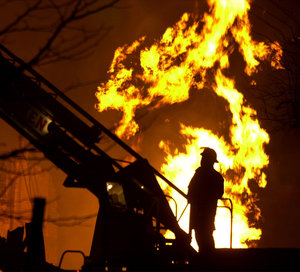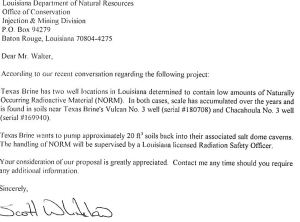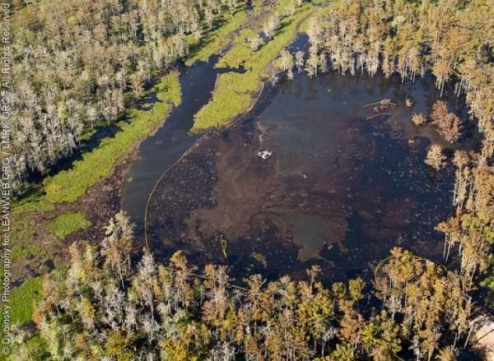According to Assumption Parish Police Jury;
Texas Brine has reported to parish officials low levels of H2S coming from the cavern well. DNR, Shaw representatives, and the OEP Director went to the site to validate Texas Brine’s reading and found no levels of H2S on their monitors. Readings will be repeated in the morning when Texas Brine flows the cavern well again. Should H2S be present at that time, appropriate actions will be taken. We will keep you updated.
Please note that no H2S readings were picked up on the community air monitors.
http://assumptionla.wordpress.com/2012/12/06/130-p-m-texas-brine-reports-h2s-at-cavern-well/
Also, take note that they also announced that Lake Oxy 3 has grown another Twenty Five Feet, so I thought it might be nice to know a little more about H2S and this was also requested by one of my readers. Thanks to Wiki, and Nora for the information contained in this article.
Hydrogen sulfide (British English: hydrogen sulphide) is the chemical compound with the formula H2S. It is a colorless, very poisonous, flammable gas with the characteristic foul odor of rotten eggs. It often results from the bacterial breakdown of organic matter in the absence of oxygen, such as in swamps and sewers; this process is commonly known as anaerobic digestion. It also occurs in volcanic gases, natural gas, and some well waters. The human body produces small amounts of H2S and uses it as a signaling molecule.
Hydrogen sulfide is slightly heavier than air; a mixture of H2S and air is explosive. Hydrogen sulfide and oxygen burn with a blue flame to form sulfur dioxide (SO2) and water. In general, hydrogen sulfide acts as a reducing agent.
Small amounts of hydrogen sulfide occur in crude petroleum, but natural gas can contain up to 90%.[7] Volcanoes and some hot springs (as well as cold springs) emit some H2S, where it probably arises via the hydrolysis of sulfide minerals, i.e. MS + H2O → MO + H2S
http://en.wikipedia.org/wiki/Hydrogen_sulfide
Presence of H2S in oilfields
Oil and natural gas are the products of the thermal conversion of decayed organic matter (called kerogen) trapped in sedimentary rocks. Methane (CH4) is the main component of natural gas, comprising 70 to 90%, while other gaseous hydrocarbons, butane, propane, and ethane, account for up to 20%. Naturally occurring contaminants present in natural gas and which have to be removed at natural gas processing facilities include water vapour, sand, oxygen, carbon dioxide, nitrogen, hydrogen sulfide (H2S) and rare gases such as helium and neon. High-sulphur kerogens release H2S during decomposition, which stays trapped within the oil and gas deposits and is frequently encountered in oilfields, often to high levels, as in west Texas (Schlumberger, 2007).
During oil exploration and production, H2S may enter drilling muds from subsurface formations and is also generated by sulphate-reducing bacteria in stored muds. Other sources of natural H2S emissions are volcanoes and geothermal sources such as hot springs. Natural gas, or any other gas mixture which contains significant amounts of H2S, is generally termed ‘sour’ if there are more than 5.7 milligrams of H2S per cubic meter of natural gas. This is equivalent to approximately 4 ppm by volume (http://www.naturalgas.org/naturalgas/processing_ng.asp).
Although the terms ‘acid gas’ and ‘sour gas’ are often used interchangeably, a sour gas is any gas that contains H2S in significant amounts, whereas an acid gas is any gas that contains significant amounts of acidic gases such as CO2 or SO2. CO2 by itself, therefore, is an acid gas but it is not a sour gas.
The H2S is removed (‘scrubbed’) from the sour gas by a process commonly referred to as ‘sweetening’ at what are termed desulphurization plants. Removal of H2S is normally done by absorption in an amine solution, while other methods include carbonate processes, solid bed absorbents (including solid desiccants like iron sponges) and physical absorption. The ‘amine process’ (also called the Girdler process) is used in 95% of US gas sweetening operations (http://www.naturalgas.org/naturalgas/processing_ng.asp).
In this process, sour gas is passed through a tower containing the amine solution, which has an affinity for sulphur and which absorbs it. Two main amine solutions are used: monoethanolamine (MEA) and diethanolamine (DEA). The emerging gas is virtually free of sulphur compounds and the H2S can be removed from the amine solution, allowing it to be reused to treat more sour gas.
The presence of H2S in an oilfield and, if exposed to the gas during oil and gas production, its possible impacts on human health, is a potential concern for potential UGS operators. H2S is a toxic, colourless gas that is odourless at high concentrations but has a smell of rotten eggs in low concentrations. Because H2S is heavier than air, it tends to accumulate in low-lying areas. It is an extremely poisonous gas and a few seconds of exposure in concentrations of anywhere between 750 and 10,000 ppm can prove lethal to people and animals. However, the effect of H2S depends on duration, frequency and intensity of exposure and the susceptibility of the individual
(Schlumberger, 2007). http://www.glossary.oilfield.slb.com/Display.cfm?Term=hydrogen sulfide
Research conducted at the University of Southern California Medical Facility has established nervous system damage can occur even at concentrations in air as low as 1 ppm (Chilingar & Endres, 2005).
H2S is hazardous to rig workers and is also corrosive, causing sulphide stress-corrosion cracking of metals, which may require costly special production equipment such as stainless steel tubing. A recent study concluded that H2S “will eventually destroy the integrity of both the steel and cement relied upon to prevent gas migration, including abandonments performed to the current standards of the DOGGR [Division of Oil, Gas and Geothermal Resources]. The corrosive conditions of hydrogen sulphide are well known, and have defied engineering solutions.”(Chilingar & Endres, 2005). Whilst this may be an extreme conclusion, it highlights the importance of proper procedures and monitoring of the presence and effects of H2S on plant and infrastructure. H2S is a recognized problem, with established procedures to mitigate it.
Incident at Gasfield, Chongquing, China
An incident in China illustrates the potentially deadly effects of H2S release during production from a gasfield. The disaster took place at the Chuandongbei gas field in Gao Qiao town in the north eastern part of Chongqing province. The incident involved a gas well blowout, which occurred at 10:00 pm on Tuesday, 23 December 2003 and resulted in the release of natural gas and H2S. According to press reports, the accident occurred as a drilling team was working on the 400 meter deep well and sent toxic fumes (sour gas – a high concentration of natural gas and (H2S) shooting 30 metres out of a failed well (UNEP: http://www.uneptie.org/pc/apell/disasters/china_well/china.htm#impacts )
The China Daily newspaper described the tragedy as “the worst of its kind in China’s history”.
“The poisonous gas hovering in the air made an area of 25 square kilometres a death zone, as many villagers were intoxicated by the fumes in their sleep”. Worst hit was the village of Xiaoyang next to the gas well, where 90% of the residents were killed, “many having died in their sleep or were too old to escape” (WSWS, 2003).
The incident was reported in Lloyd’s Casualty Week for 23rd Jan 2003 as follows: “officers investigating a gas leak which killed 243 people in western China have arrested three oil company workers on suspicion of dismantling safety features and mishandling drilling equipment……one of China’s worst industrial accidents…..the investigation has forced the resignation of a vice president of state owned China National Petroleum Corporation. …….The accident sent a deadly cloud of poisonous hydrogen sulphide over nearby villages in a poor mountainous area. Villagers died in their sleep or were struck down while trying to flee. More than 9,000 people were treated for injuries and 60,000 were forced to evacuate the area. Hospitals reported…… 396 were still being treated for injuries, several of them in critical condition.”





















